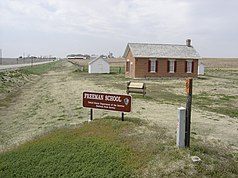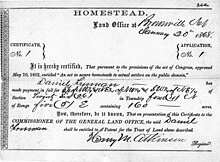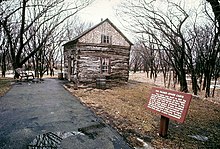Homestead National Monument of America
| Homestead National Monument of America | ||
|---|---|---|
| Freeman School, part of the memorial | ||
|
|
||
| Location: | Nebraska , United States | |
| Specialty: | One of the first homesteads in the United States | |
| Next city: | Beatrice | |
| Surface: | 0.8 km² | |
| Founding: | March 19, 1936 | |
| Visitors: | 70,200 (2007) | |
Homestead National Monument of America is a national monument- type memorial in Gage County in south-east of the US state of Nebraska to commemorate the settlement of the American West. The monument sits on the grounds of the first homestead farm in Nebraska and possibly the first in the United States.
Daniel Freeman acquired the farm in 1862 and allegedly applied for his homestead ten minutes after midnight on January 1, 1863, the day the law came into effect. The title deed with the number 1 was issued after a five-year waiting period on January 20, 1868. The farm was recognized by the United States Congress in 1936 as the first homestead and designated as a memorial. It is looked after by the National Park Service .
history
Freeman was born in Ohio in 1826 , studied medicine and was licensed to practice medicine . In the Civil War he volunteered and was stationed in Fort Leavenworth , Nebraska in 1862 . When the Homestead Act was passed, Freeman selected 160 acres (64.75 hectares) of farmland on the road to Fort Kearny west of Beatrice, Nebraska. His farm was on Cub Creek and had high grass prairie that was good arable land, forest and year-round water supply. The region was originally the hunting and roaming area of the Kansa , Otoe - Missouria - and Pawnee Indians, the federal government bought the area from the Kansa in 1825 and initially wanted to establish an Indian territory. From 1850 onwards, settlers increasingly invaded the region and in 1854 the settlement was formally released in the Kansas-Nebraska Act . Freeman was able to cheaply settle a squatter (resident without title) who had arrived earlier in 1862 and had his claim registered on the first day of the law.
In 1865 he married his brother's fiancée, who had died in the war. With Agnes Freman he had eight children, seven of whom reached adulthood. They lived in the squatter's small log cabin until 1866, when Freeman built a larger wooden house around which several outbuildings were built in the years that followed. In 1876 the family moved to a spacious brick building that Freeman had built in the style of the time.
Almost from the beginning he did not manage the farm himself, but took on one or more tenants , provided the land and teams of oxen and received 50% of the income in return. He was able to purchase more land from the income from the flourishing farm and temporarily owned over 400 hectares.
In addition to managing his farm Daniel Freeman resumed the practice as a doctor, settled for coroner ( coroner choose) formed in the self-study in legal matters and was a magistrate and sheriff elected. He led a high-profile process in which he enforced the separation of church and state in his children's school and had to go to the Nebraska State Supreme Court. He presented himself to the public as the first homesteader in the United States, used stationery on which his log cabin was depicted, and introduced himself as a small farmer rather than a wealthy landowner.
He died on the farm in 1908 and his wife lived in Beatrice until 1931. The Freeman family ran the farm until 1936 when it was purchased by the US federal government and designated as a memorial.
The National Monument
The memorial has been renaturing the original high grass prairie since 1939 to give visitors the impression that Freeman and other homesteaders had when they arrived on their land. The areas are among the oldest and best developed reconstructed prairie areas. There are also demonstration areas for historic arable farming. The two wooden buildings and the brick building have not been preserved. In 1971, the Freeman School to the north came to the memorial: the one-room school was in use from 1872 to 1967 and is typical of the Midwest.
The Palmer-Epard log cabin with an area of around 20 m² is also located on the site . It was built around 1867 as a typical log cabin in the region by a homesteader in the Freemans neighborhood. In 1966 it was handed over to the National Monument, moved to its current location and restored. Also part of the National Monument is the grave of Daniel and Agnes Freeman.
A newly built visitor center with a museum on the history of the settlement opened in May 2007.
Web links
- National Park Service: Homestead National Monument of America (official site; English)
- Homestead National Monument: Cultural Landscape Report (PDF file; 20.03 MB) - History of Daniel Freeman's Homestead and the memorial (294 pages)





